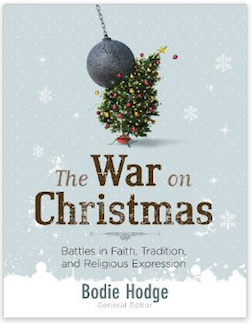It should come as no surprise that, as our culture drifts further from its Christian foundations, there is a lot of talk about the nature of truth, justice, morals, and reality. The current controversy about Christmas is an important part of this enormous debate. The War on Christmas: Battles in Faith, Tradition, and Religious Expression edited by Bodie Hodge was written to equip Christians to join the discussion and spread the good news.
As Christian parents, we can be part of this movement. By teaching our children to read the Bible and to understand what it says—as well as what it does not say—we are not only strengthening them, but also strengthening our culture.
For, as the introduction of The War on Christmas points out, “If we as Christians do not know what we are celebrating, how can we share this good news of Christ with unbelievers?”
A blog tour has been put together to highlight each chapter of The War on Christmas, and I’m writing about chapter 15, “What was the Christmas Star?”
Let’s read the story from Matthew 2:
After Jesus was born in Bethlehem in Judea, during the time of King Herod, Magi from the east came to Jerusalem and asked, “Where is the one who has been born king of the Jews? We saw his star when it rose and have come to worship him.” (Matthew 2:1,2)
King Herod, alarmed, ascertained that the Messiah was to be born in Bethlehem.
Then Herod called the Magi secretly and found out from them the exact time the star had appeared. He sent them to Bethlehem and said, “Go and search carefully for the child. As soon as you find him, report to me, so that I too may go and worship him.
After they had heard the king, they went on their way, and the star they had seen when it rose went ahead of them until it stopped over the place where the child was. When they saw the star, they were overjoyed. On coming to the house, they saw the child with his mother Mary, and they bowed down and worshiped him. Then they opened their treasures and presented him with gifts of gold, frankincense and myrrh. And having been warned in a dream not to go back to Herod, they returned to their country by another route. (Matthew 2:7-12)
There have been many speculations about what this star could have been. The Greek word apparently means any luminous object in the night sky, but careful reading of the text makes most common explanations seem suspect.
Some suggest that the ‘star’ could have been a supernova, but in that case Herod would not have had to ask when it had appeared; he would have known. A comet would also have been a well-known phenomenon in an age when everyone was familiar with the night sky. Furthermore, neither of these would have been able to show the Magi where Jesus was by stopping over his house.
Conjunctions of planets or planets and stars would have been amazing to the Magi but not necessarily noticed by King Herod. However, none of the conjunctions seen near that time (astronomers can calculate backwards in time to determine the positions of the planets and stars at any given time) would have been visible as a single star at two separate times, as a straightforward reading of Matthew 2 requires.
So what was the star? The simple answer, according to The War on Christmas, is that we don’t know. It was some miraculous light that informed the Magi of the Messiah’s birth, that guided them from Jerusalem to Bethlehem, and that honored the King of Kings.
This chapter of The War on Christmas was, obviously, a combination of science and Bible study. Scientific concepts were carefully explained, the Bible was treated with respect, and the discussion was both interesting and relevant.
Other chapters in the book focus more on history, archeology, or the gospel, and each one is interesting and worthwhile in itself. Throughout, the book emphasizes a straightforward reading of the Bible, the true significance of Christmas (that Christ came to earth to save us from our sins), and the truth about modern Christmas traditions.
Put out by Answers in Genesis, The War on Christmas also points out that if Creation and the Fall are not historical events, we do not need Jesus to die for our sins. Its message to us is simple: Read the Bible so you know why the battle for Christmas is significant and so you know what Christmas is really all about.
For more information you can see the book trailer and follow the blog tour.
I very rarely host giveaways, but this one seems worthwhile. In order to win a copy of the book and a t-shirt, please leave a comment below discussing the Christmas controversy. (This giveaway is for residents of Canada and the USA and will end December 20–extended to Dec 24 because of trouble with the comment box.) Visit the rest of the blog tour for more chances to win this book.
This is yet another book in the 2013 52 Books in 52 Weeks Challenge and is also linked to Saturday Reviews , Encourage One Another Wednesday, Canadian-Friendly Giveaways, and Giveaways Galore.
Disclosure: I was given a review copy of this book and a t-shirt. As usual, I have expressed my honest opinion and am not compensated for this review.

